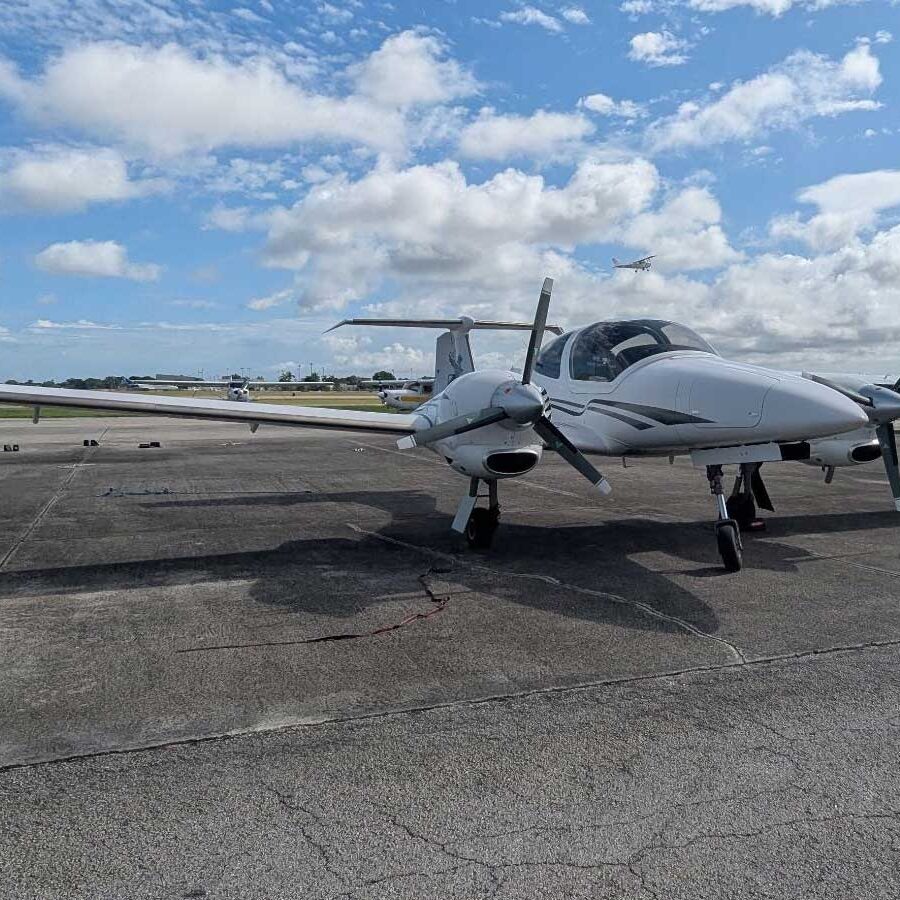If you’re serious about flying professionally, that single-engine license is just chapter one. Real careers live in the twin-engine world. And Fly Legacy in Florida is the only place you can actually learn to fly big-boy planes.
Why Bother With Twin-Engine Planes?
- Airlines Don’t Hire Single-Engine Heroes: Regional jets? Turboprops? All twins. No rating = no interview.
- You’ll Outearn Your Peers: Corporate/charter gigs pay 30-50% more for multi-engine quals.
- Redundancy = Not Dying: Lose an engine at 10,000 feet? You’ll yawn while your single-engine buddies sweat.
Why Florida Eats Other States for Breakfast
- Weather’s On Your Side: 300+ flyable days = no “canceled for snow” texts. You train consistently.
- Modern Fleet: Fly Legacy runs Piper Pilot 100s and Diamond DA-42 that don’t make it feel like 1973. Modern avionics, working AC.
- Instructors Who Flew Real Jets: Not just CFIs. Think ex-airline captains, corporate vets, military crew dogs. They’ve bled hydraulic fluid.
The Nuts & Bolts of Training
Here’s the real breakdown of what twin-engine training looks like:
Week 1: Systems & Scenarios
- Engine-Out Drills: “Feather the prop!” becomes muscle memory. You’ll practice until one-engine landings feel boring.
- Weight & Balance training: Twin-Engines are picky. Nail this or watch your climb rate tank.
- Avionics Deep Dive: Two engines = twice the systems. No more “hopeful knob-twisting.”
Week 2: Advanced Pain
- IFR in Busy Airspace: Navigate Miami’s Class B while managing two hungry engines. Stressful? Yes. Unbeatable training? Absolutely.
- Cross-Country Reality Checks: Fly real routes to real airports. No training wheels.
Timeline & Cash Talk
- 2 Weeks Tops: Florida’s weather lets you crush it fast. Rain? Pfft.
- Costs More Per Hour? Yeah. Twins gulp fuel. But Fly Legacy will bundle it for you and offer financial assistance.
- Secret Perk: Every twin hour counts toward ATP minimums. Start now, thank yourself at 1,500 hours.
Picking Your School
- Kick the Tires: If the Seminole’s interior looks like a crime scene, walk away.
- Grill the Instructor: “How many multi-engine hours you got?” (Under 500? Hard pass.)
- Ask About Airline Handshakes: Some schools feed directly to regionals (Envoy, SkyWest). Game-changer.
- Flex Scheduling: Working a day job? International? Fly Legacy offers flights and training on your schedule and that means nights and weekends.
The Real Reward
After your checkride? That first takeoff in a twin hits different. The rumble. The raw climb power. Knowing you’ve just unlocked:
✓ Turboprop jobs
✓ Regional airline pathways
✓ Corporate gigs flying CEOs
✓ Respect at pilot interviews
Bottom Line
Florida’s not just palm trees and beaches. It’s where pilots turn pro. Twin training here isn’t an “option”, it’s the accelerator pedal for your career.
1. What is twin-engine training?
Twin-engine training teaches you how to operate aircraft with two engines, usually leading to a Multi-Engine Rating (MER). It’s an advanced certification that builds on your Private or Commercial Pilot License.
2. Why is twin-engine training important for my aviation career?
Most airline and charter jobs require experience with multi-engine aircraft. Having a Multi-Engine Rating opens the door to commercial pilot jobs, cargo operations, and corporate flying.
3. Why is Florida a great place for twin-engine training?
Florida’s consistently good flying weather allows more flight hours with fewer delays. Many schools offer accelerated multi-engine programs and have dedicated twin-engine fleets like the Diamond DA-42.
4. How long does it take to complete twin-engine training?
You can complete most multi-engine training programs in 7 days, depending on your availability and proficiency. Some full-time students complete it in a weekend.
5. What aircraft are used for multi-engine training in Florida?
Common training aircraft is the Diamond DA-42. These aircraft are designed specifically for training with twin engines.
6. Is twin-engine training difficult?
It’s more challenging than single-engine training due to engine-out procedures, asymmetric thrust, and faster decision-making. But with a good instructor, it’s manageable and very rewarding.
7. Will twin-engine flight time help me get hired faster?
Yes. Airlines and charter companies prefer candidates with multi-engine experience. Even small regional airlines look for pilots who have logged time in twin-engine aircraft.
8. Can international students take twin-engine training in Florida?
Absolutely. Many flight schools in Florida are SEVIS-approved and offer multi-engine courses as part of FAA commercial training paths for international students.
9. Does twin-engine training count toward my total flight hours?
Yes. Every hour flown in a multi-engine aircraft is loggable and counts toward your total flight time, which is critical for meeting ATP (Airline Transport Pilot) requirements.
10. How much does twin-engine training cost in Florida?
Costs are just under $8,000 at Fly Legacy!




